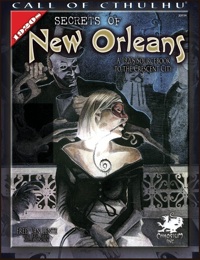
|
About OgreCave and its staff
|

|
by Demian Katz
The latest in Chaosium's "Secrets" line isn't as new as the 2009 copyright date might lead you to believe. It was previously published in 1997 as the less colorfully titled New Orleans Guidebook, and little has changed since then but the name and interior layout. Fortunately, as long as you don't get fooled into buying something you already own, you shouldn't be disappointed with this sourcebook. New Orleans is a great setting for a horror game, and this volume's return to print is entirely welcome. At only 90 pages, this is slimmer than some other recent "Secrets" volumes, but the shorter length doesn't really hurt the book. It's packed full of useful tidbits, and (unlike the dismal Secrets of Morocco) makes good use of the space it has available.
Surviving the Big Easy Obviously, a book of this size cannot be comprehensive (part of the reason that the bibliography is so welcome), but Secrets of New Orleans does a good job of making the content it presents usable. Game stats (and, in some cases, fictionalized back-stories) are provided for famous literary figures, pirates, politicians and voodoo practitioners. In most cases, the NPC descriptions include good reasons why the players might run across these people during the course of their investigations. Typical locations like homes, nightclubs and voodoo humfors are presented as if they were specific locations in a scenario, complete with maps and detailed descriptions, making them easy to drop into a game. The complex cultural and racial politics of the city are well-described, offering interesting role-playing possibilities for players willing to deal with potentially sensitive subject matter. Secret societies working at cross purposes provide opportunities for mysterious but eventually explainable plot twists. The book's voodoo coverage describes some of the most common and infamous spells using the standard Call of Cthulhu magic system while emphasizing that voodoo is flexible and many variant effects are possible. Ceremonies are described in enough detail to help with atmosphere, but left open-ended enough for flexible interpretation. The exact relationship between voodoo and the Mythos is never made explicit, but some detailed suggestions (such as which of the voodoo spirits known as loa might correspond with which of the Old Ones) are provided. It's hard to read this book without seeing a lot of gaming potential, and the sample scenario helps to underline the strengths of the rest of the text.
Conclusions Assuming you haven't seen it before, though, Secrets of New Orleans is well worth checking out. Whether you want to pay a short visit to the city or set up shop there for good, this book will serve you well as a starting point.
|
||||
 Secrets of New Orleans
Secrets of New Orleans